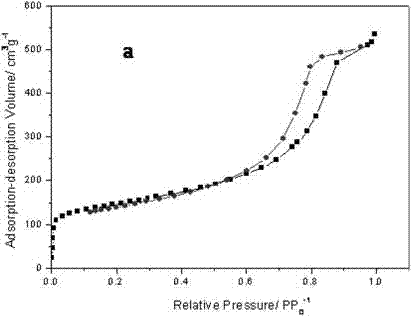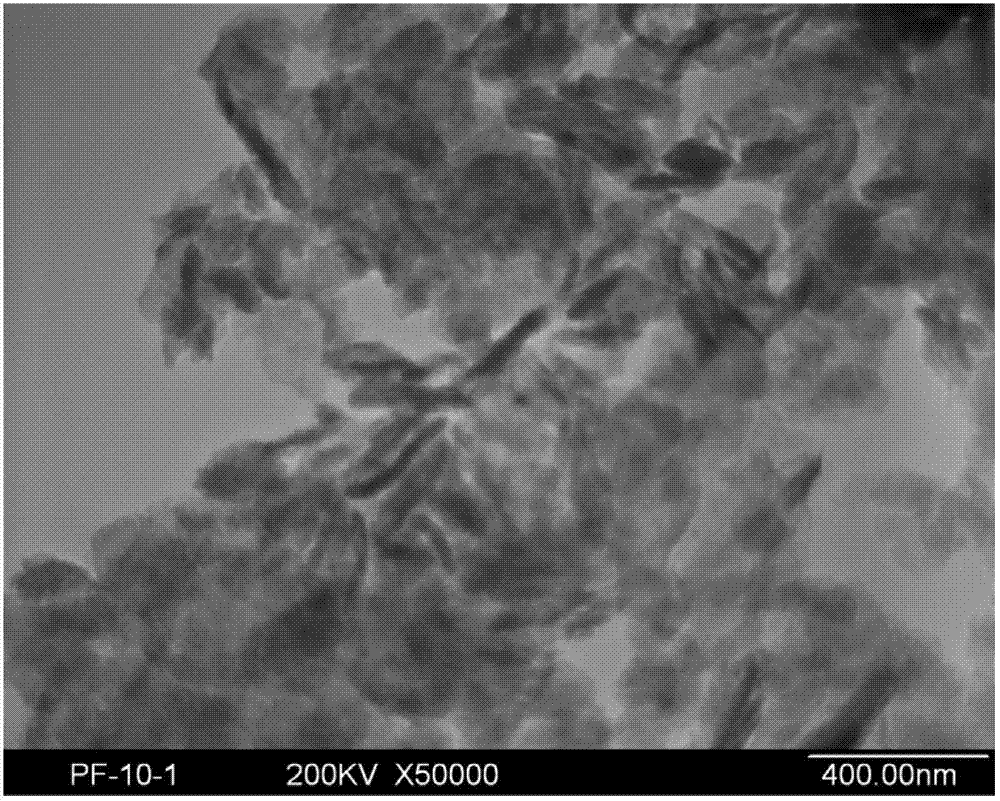Method for preparing graphene crosslinked type organic aerogel and carbon aerogel by normal-pressure drying
A carbon aerogel, atmospheric drying technology, used in carbon preparation/purification, chemical instruments and methods, inorganic chemistry, etc., can solve problems such as high drying shrinkage rate, and achieve simplified operation process, resistance to tension, simple and fast The effect of preparation
- Summary
- Abstract
- Description
- Claims
- Application Information
AI Technical Summary
Problems solved by technology
Method used
Image
Examples
Embodiment 1
[0019] Example 1: Using phenol (P) and formaldehyde (F) as the reaction monomers, sodium hydroxide as the catalyst (C), and water as the solvent, according to the ratio of P / F=0.33, P / C=20, the solid For a solution with a content of 30wt%, add 2wt% of graphene oxide as a crosslinking agent and mix uniformly, heat at 60°C for 60 minutes to obtain a graphene crosslinked organic hydrogel, and put it in a water bath at 85°C for 72h aging. Then take out the gel column and dry it at 60°C for 24 hours under normal pressure to form an organic aerogel. The organic aerogel is put into a carbonization furnace, is protected by nitrogen, and is carbonized at a constant temperature of 900° C. for 2 hours to form a carbon aerogel. The specific surface area of carbon aerogel is 485m 2 / g, pore volume 0.72cm 3 / g, the carbonization shrinkage rate is 49.9%.
Embodiment 2
[0020] Example 2: Using resorcinol (R) and formaldehyde (F) as reaction monomers, sodium carbonate as catalyst, and water as solvent, according to the ratio of R / F=0.5 and R / C=200, the solid content is formulated For a 5wt% solution, add 20wt% of functionalized graphene oxide as a crosslinking agent and mix uniformly, obtain a graphene crosslinked organic hydrogel at 20°C for 5 minutes, and place it in a 75°C water bath for aging for 7 days. Then take out the hydrogel column and dry it under infrared light for 10 hours to form organic aerogel. The organic aerogel is put into a carbonization furnace, is protected by nitrogen, and is carbonized at a constant temperature of 800° C. for 1 hour to form a carbon aerogel. The specific surface area of carbon aerogel is 382m 2 / g, pore volume 0.42cm 3 / g, the carbonization shrinkage rate is 61.9%.
Embodiment 3
[0021] Example 3: Using resorcinol (R) and formaldehyde (F) as the reaction monomers, sodium carbonate as the catalyst, ethanol as the solvent, according to the ratio of R / F=0.5, R / C=200, the solid content For a 40wt% solution, add 0.5wt% of graphene oxide as a crosslinking agent to mix uniformly, heat at 80°C for 180 minutes to obtain a graphene crosslinked organic hydrogel, and put it in a water bath at 80°C for 72h aging. Then take out the gel column and dry it at room temperature under normal pressure for 48 hours, and then dry it at 120°C for 5 hours to form an organic aerogel. The organic aerogel is put into a carbonization furnace, is protected by nitrogen, and is carbonized at a constant temperature of 1100°C for 2 hours to form a carbon aerogel. The specific surface area of carbon aerogel is 732m 2 / g, pore volume 1.03cm 3 / g, the average pore diameter is 5.2nm.
PUM
| Property | Measurement | Unit |
|---|---|---|
| density | aaaaa | aaaaa |
| pore size | aaaaa | aaaaa |
| specific surface area | aaaaa | aaaaa |
Abstract
Description
Claims
Application Information
 Login to View More
Login to View More - R&D
- Intellectual Property
- Life Sciences
- Materials
- Tech Scout
- Unparalleled Data Quality
- Higher Quality Content
- 60% Fewer Hallucinations
Browse by: Latest US Patents, China's latest patents, Technical Efficacy Thesaurus, Application Domain, Technology Topic, Popular Technical Reports.
© 2025 PatSnap. All rights reserved.Legal|Privacy policy|Modern Slavery Act Transparency Statement|Sitemap|About US| Contact US: help@patsnap.com



